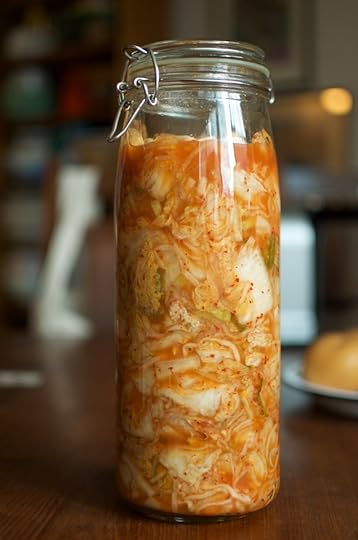The Agricola Cookbook and a Kimchi Recipe
I am a relative newcomer to kimchi. It wasn’t part of my family’s pickle culture (we leaned Jewish and Japanese) when I was growing up and I don’t think I had even so much as a taste of it until college. After that first bite, spent about a decade feeling kimchi-neutral. I’d eat a bite or two at Korean restaurants, but it wasn’t something I sought out.
Then something shifted. I became someone who always had a jar of kimchi (whether homemade or store bought) in the fridge. These days, I eat it with eggs, layered into quesadillas, on top of avocado toast, or even just out of the jar when nothing else appeals. It is one of my favorite ways to add flavor and texture to just about everything.
Over the years, I’ve tried a number of different recipes for kimchi, and oddly, the proportions for my favorite version don’t come from a specialized fermentation book or one devoted to Korean cuisine. Instead, the foundational recipe comes from the Agricola Cookbook, a book born from a farm and restaurant in the Princeton, NJ area.
The essentials of basic kimchi are the same. They are napa cabbage, daikon, green onion, garlic, ginger, salt, and chile powder. Some recipes have you add rice flour (for thickening the spice paste), shrimp paste or fish sauce (to increase the funky umami), apple or asian pear (for sweetness), or carrot (for more crunch and color).
For my uses, I find that the simpler approach is best. The most exotic ingredient you’ll find in my batch is the Korean chili powder called gochugaru that gives kimchi its trademark color and spice. You can get it at most large Asian grocery stores, though I typically buy it a pound at a time from Amazon.
The process takes about a week. I start by salted the cabbage and letting it rest overnight. The next day, I rinse and drain it, add the julienned daikon (made using one of these peelers), and lengths of green onion. I make a spice paste with garlic, ginger, and sugar, add the gochugaru and then rub it into the vegetables. Then I pack it into a jar or crock where it can ferment for five or six days. When it’s done, I transfer it into a jar for the fridge and start eating down the batch. Easy and delicious.
I’ll be taking some of this kimchi with me to the next Philly Food Swap. It’s on Monday, November 9 and there are still spots available, if you want to join us!
PrintBasic Kimchi
Ingredients
1 large head of napa cabbage (3-4 pounds), cut into 2-inch chunks1/3 cup kosher salt
1 pound daikon radish, julienned
1 bundle green onions, trimmed and cut into 2-inch lengths
8-9 cloves garlic, peeled
3 inches fresh ginger, peeled
1 tablespoon sugar
4-7 tablespoons gochugaru
Instructions
Place the chopped cabbage in a large bowl and add salt. Use your hands to rub the salt into the cabbage and let it sit overnight.The next day, rinse the cabbage and let it drain. Return the cabbage to the bowl and add the prepared daikon and green onion.
In a small food chopper or processor, combine the garlic cloves, ginger, and sugar. Chop until a paste forms. Add it to the bowl with the vegetables.
Finally, add the gochugaru. For a batch this size, I like to use 5-6 tablespoons. That makes a mildly spice batch. If you're very sensitive to heat, use less. If you want something a little more zippy, add more.
Use your hands to work the spices into the vegetables. Pack it all into a half gallon jar or small crock. Weigh it down with a 4 ounce jar or pickling weights and cover the vessel with an airlock or kitchen cloth (the airlock helps keep the fragrance confined).
Let the kimchi ferment for five to six days, until you like how it tastes.
When the kimchi is done, portion it into jars and refrigerate. 3.1http://foodinjars.com/2015/11/the-agricola-cookbook-and-a-kimchi-recipe/
Related Posts:
Tiny White Turnips, Fermented
Pickle Pipe Waterless Fermentation System Launches Today!
International Can-It-Forward Day and Onion Pickles from the Ball Blue Book









